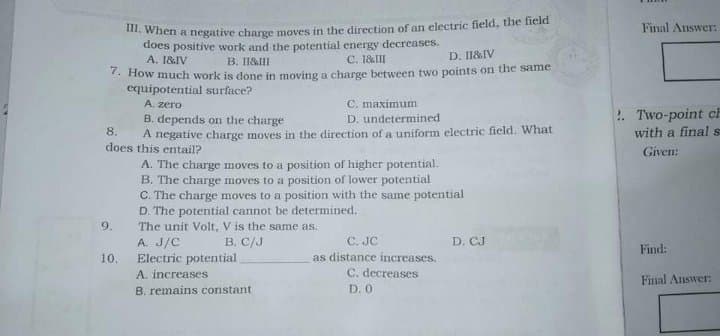The unit Volt, V is the same as. B. C/J C. JC D. CJ A. J/C Electric potential as distance increases. C. decreases D. 0 A. increases B. remains constant
The unit Volt, V is the same as. B. C/J C. JC D. CJ A. J/C Electric potential as distance increases. C. decreases D. 0 A. increases B. remains constant
Principles of Physics: A Calculus-Based Text
5th Edition
ISBN:9781133104261
Author:Raymond A. Serway, John W. Jewett
Publisher:Raymond A. Serway, John W. Jewett
Chapter20: Electric Potential And Capacitance
Section: Chapter Questions
Problem 8OQ: In a certain region of space, a uniform electric field is in the x direction. A particle with...
Related questions
Question
9 and 10

Transcribed Image Text:when a negative charge moves in the direction of an electric field, the field
does positive work and the potential energy decreases.
A. 1&IV
Final Answer:
C. 1&III
D. I1&IV
B. I1&III
- How much work is done in moving a charge between two points on the same
equipotential surface?
A. zero
C. maximum
!. Two-point ch
B. depends on the charge
A negative charge moves in the direction of a uniform electric field. What
D. undetermined
8.
with a final s
does this entail?
Given:
A. The charge moves to a position of higher potential.
B. The charge moves to a position of lower potential
C. The charge moves to a position with the same potential
D. The potential cannot be determined.
The unit Volt, V is the same as.
A. J/C
Electric potential
A. increases
9.
C. JC
as distance increases.
C. decreases
D. 0
B. C/J
D. CJ
Find:
10.
Final Answer:
B. remains constant
Expert Solution
This question has been solved!
Explore an expertly crafted, step-by-step solution for a thorough understanding of key concepts.
Step by step
Solved in 2 steps

Knowledge Booster
Learn more about
Need a deep-dive on the concept behind this application? Look no further. Learn more about this topic, physics and related others by exploring similar questions and additional content below.Recommended textbooks for you

Principles of Physics: A Calculus-Based Text
Physics
ISBN:
9781133104261
Author:
Raymond A. Serway, John W. Jewett
Publisher:
Cengage Learning

Physics for Scientists and Engineers, Technology …
Physics
ISBN:
9781305116399
Author:
Raymond A. Serway, John W. Jewett
Publisher:
Cengage Learning

Physics for Scientists and Engineers
Physics
ISBN:
9781337553278
Author:
Raymond A. Serway, John W. Jewett
Publisher:
Cengage Learning

Principles of Physics: A Calculus-Based Text
Physics
ISBN:
9781133104261
Author:
Raymond A. Serway, John W. Jewett
Publisher:
Cengage Learning

Physics for Scientists and Engineers, Technology …
Physics
ISBN:
9781305116399
Author:
Raymond A. Serway, John W. Jewett
Publisher:
Cengage Learning

Physics for Scientists and Engineers
Physics
ISBN:
9781337553278
Author:
Raymond A. Serway, John W. Jewett
Publisher:
Cengage Learning

Physics for Scientists and Engineers with Modern …
Physics
ISBN:
9781337553292
Author:
Raymond A. Serway, John W. Jewett
Publisher:
Cengage Learning

Physics for Scientists and Engineers: Foundations…
Physics
ISBN:
9781133939146
Author:
Katz, Debora M.
Publisher:
Cengage Learning
